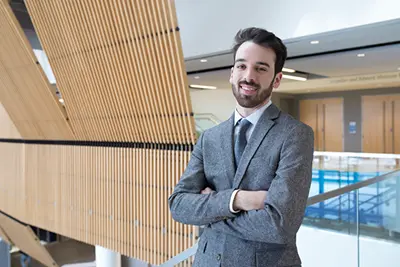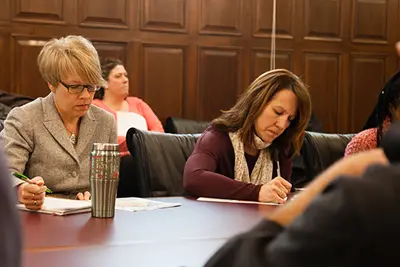Political Scientist Angélica Durán Martínez’s Book Wins Award
 Image by Juan Carlos Cruz
Image by Juan Carlos Cruz
12/13/2018
By Katharine Webster
Growing up in Bogotá, Colombia, Asst. Prof. Angélica Durán Martínez was acutely aware of violence by criminals, left-wing guerrillas and right-wing paramilitaries – and of the cocaine trafficking that funded all the fighting.
While an undergraduate at the National University of Colombia, she studied participatory democracy and political theory. Then, while pursuing her master’s degree at New York University on a Fulbright Fellowship, she was assigned to work for the United Nations’ Political Affairs Department, researching organized crime and violence in Central America and the Caribbean. That inspired her to investigate political factors affecting drug trafficking violence in Colombia and Mexico.
This year, she published the results in her first book, "The Politics of Drug Violence: Criminals, Cops, and Politicians in Colombia and Mexico" (Oxford University Press). Recently, the International Association for the Study of Organized Crime named it the year’s best book in the field, citing “the outstanding quality of the research and your model's potential applicability to other contexts.”
Durán Martínez teaches comparative and Latin American politics to undergraduates in the Political Science Department, as well as research design and methods to students in the Global Studies Ph.D. program. She has created her own courses, too, including The War on Drugs and Theories of Political and Criminal Violence.
Q: How did you get interested in drug trafficking violence, and why did you focus on Colombia and Mexico?
A: Growing up in Colombia, I couldn’t ignore the reality around me. But when I started college, I was more interested in political theory than in organized crime and drug trafficking.
The fellowship at the United Nations started pulling together all my interests, and I began looking at the intersection between drug violence and political conditions. Then, when I started my Ph.D. at Brown in 2007, the drug-related violence in Mexico just jumped out at me. Nobody foresaw how quickly it would escalate, and I wanted to understand why.
I also wanted to know why some major drug trafficking centers had high levels of violence and grisly public executions, while in others, the violence was lower or remained largely invisible.
Q: What are some of the key things you learned?
A: Through my research in five different cities, I began to better understand political factors that contributed to variations in the frequency and type – hidden or visible – of violence. I found patterns related to three main factors: whether the drug cartels had a market monopoly or were fighting for turf; whether they were outsourcing the violence to street gangs or performing the killings themselves; and whether the state security apparatus was fragmented or cohesive.
Not surprisingly, I found that the frequency of violence escalated when organizations were fighting for turf or when assassinations were outsourced to street gangs. I also found that drug traffickers who face a cohesive and effective security apparatus – as well as those protected by corrupt state actors – often have an incentive to minimize and hide their violence, so as not to cause a public outcry and force a crackdown. On the other hand, trafficking organizations in areas with fragmented security forces may have incentives to maintain control through visible violence, including gruesome public assassinations, bombings and shootouts.
 Image by Duran Martinez
Image by Duran Martinez
Q: Studying drug trafficking violence must pose some significant challenges. How did you do your research?
A: I was familiar with Colombia, of course, and I chose to study Medellín and Cali because they had distinct patterns of violence. In Mexico, I began by researching Culiacán, home to the powerful Sinaloa cartel, and Nuevo Laredo on the U.S. border. But as I began my fieldwork, I realized that Nuevo Laredo was too dangerous. Assoc. Prof. David Shirk at the University of San Diego recommended that I study the border cities of Tijuana and Ciudad Juárez instead.
During 15 months of fieldwork, I visited each city several times for short periods, so as not to draw too much attention. I gathered news accounts and police and court records of drug-related murders from 1984 through 2011. I also interviewed politicians, journalists, law enforcement, victims’ family members and even some members of trafficking organizations.
Q: On his first day in office on Dec. 1, Mexican President Andres Manuel López Obrador said he wants to mobilize the military to combat drug violence. Is this an effective strategy?
A: No. We know from previous such campaigns in Mexico, and what we are also seeing in the Philippines under President Duterte, that indiscriminate military operations against organized crime increase both direct and collateral violence and deaths. When cartel leaders or “kingpins” are arrested, their organizations usually fragment, leading to bloody battles for control. The organizations also commit more violence during government crackdowns as they try to establish new production sites and smuggling routes.
At the same time, conflicts between different enforcement agencies increase, as do opportunities for corruption. And because the military is under immense pressure to show progress in the “war on drugs,” human rights violations multiply, including false arrests and confessions produced by torture, along with extrajudicial killings and disappearances.
 Image by Duran Martinez
Image by Duran Martinez
Unfortunately, though, there is often strong public support for putting soldiers in the streets – at least in the beginning. When I was doing my field research in 2010 and 2011, 80 percent of people in Mexico supported using the military to combat drug violence, and the same proportion of Filipinos supports Duterte’s drug war.
Q: What are some better approaches?
A: You cannot completely eliminate drug trafficking or drug use, but you can design targeted interventions that minimize violence. Governments in the drug-producing countries need to put more resources into long-term social and economic solutions, including education and building up state capacity.
They also need to educate the public about the ineffectiveness of militarized combat. People often dismiss the human costs of illegal drug trafficking under the assumption that it’s just criminals killing each other. But a lot of the people who are dying are young men from marginalized areas where the state security apparatus is weak or nonexistent – and they have no choice but to join a gang or be killed.
Also, although it’s not a popular idea, decriminalization or legalization of drugs in consumer nations would help a lot by removing the financial incentives that drive illegal markets. We’re already seeing this with the legalization of marijuana in some states and the decriminalization of all drugs in Portugal.




